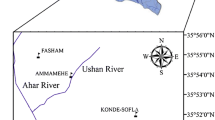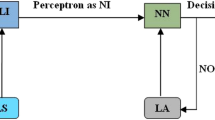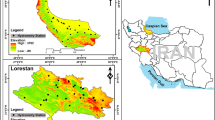Abstract
Information about suspended sediment concentration (SSC) in the stream is vital for sustainability of water conservation and erosion control planning, designing and monitoring. In this research, prediction of SSC has been done using artificial neural network (ANN), support vector regression (SVR) and multi-linear regression (MLR) models. Performance evaluation of developed models has been carried out on the basis of root mean square error (RMSE), correlation coefficient (r), coefficient of efficiency (CE) and pooled average relative error (PARE). Cross-correlation function (CCF) validated that gamma test (GT) is an appropriate tool for the selection of most responsive input variables. On the basis of GT and CCF, GT-6 model was selected as the model with most effective input variables, with the values of gamma, standard error and V-ratio as 0.0643, 0.00583 and 0.2570, respectively. The ANN (6–3-1) model performed better than the other single and double hidden layered ANN models with the values of r, RMSE, CE and PARE as 0.939, 0.0063 g/l, 85.17 and 0.0160, respectively. The performance of the SVR model was found better with the values of r, RMSE, CE and PARE as 0.906, 0.018 g/l, 79.09 and 0001, respectively, but slightly poor than the selected ANN (6–3-1) model. The values of r, RMSE, CE and PARE were found as 0.899, 0.0312 g/l, 65.15 and − 0.0031, respectively, in the case of MLR model. The present study revealed that among the ANN, SVR and MLR models, the ANN model with a single hidden layer is most suitable for observed SSC. The present study offers the simple efficient model to estimate the suspended sediment concentration in the stream with minimum error using limited data set.


















Similar content being viewed by others
Availability of data and materials
Limited data is used in the present study. No need to make it public domain. If required it will be sent to the editor.
References
Adib A, Mahmoodi A (2017) Prediction of suspended sediment load using ANN GA conjunction model with Markov chain approach at flood conditions. KSCE J Civ Eng 21:447–457. https://doi.org/10.1007/s12205-016-0444-2
Akande KO, Owolabi TO, Olatunji SO, Abdul Raheem A (2017) hybrid particles warm optimization and support vector regression model for modelling permeabilityprediction of hydrocarbon reservoir. J Pet Sci Eng 150:43–53
Ali SH (2012) Miner for OACCR: Case of medical data analysis in knowledge discovery," IEEE, 2012 6th International Conference on Sciences of Electronics, Technologies of Information and Telecommunications (SETIT), Sousse, pp. 962–975. https://doi.org/10.1109/SETIT.2012.6482043
Ali SH (2013) Novel Approach for Generating the key of stream cipher system using random forest data mining algorithm, Sixth International Conference on Developments in eSystems Engineering, Abu Dhabi, pp. 259–269. https://doi.org/10.1109/DeSE.2013.54
Alizadeh MJ, Kavianpou MR, Kisi O, Nourani V (2017) A new approach for simulating and forecasting the rainfall-runoff process within the next two months. J Hydrol 548:588–597. https://doi.org/10.1016/j.jhydrol.2017.03.032
Al-Janabi S, Alkaim AF (2020) A nifty collaborative analysis to predicting a novel tool (DRFLLS) for missing values estimation. Soft Comput 24:555–569. https://doi.org/10.1007/s00500-019-03972-x
Al-Janabi S, Rawat S, Patel A, Shourbaji IA (2015) Design and evaluation of a hybrid system for detection and prediction of faults in electrical transformers. Electr Power Energy Syst 67:324–335. https://doi.org/10.1016/j.ijepes.2014.12.005
Al-Janabi S, Mohammad M, Sultan AA (2019) A new method for prediction of air pollution based on intelligent computation. Soft Comput 24:661–680. https://doi.org/10.1007/s00500-019-04495-1
Al-Janabi S, Alkaim AF, Adel Z (2020) An innovative synthesis of deep learning techniques (DCapsNet & DCOM) for generation electrical renewable energy from wind energy. Soft Comput 24:10943–10962. https://doi.org/10.1007/s00500-020-04905-9
Al-Janabi S, Alwan E (2017) Soft mathematical system to solve black box problem through development the FARB based on hyperbolic and polynomial functions, IEEE, 2017 10th International Conference on Developments in eSystems Engineering (DeSE), Paris, pp. 37–42. https://doi.org/10.1109/DeSE.2017.23
Al-Janabi S, Shourbaji IA, Shojafar M, Abdelhag M (2017) Mobile cloud computing: challenges and future research directions," IEEE, 2017 10th International Conference on Developments in eSystems Engineering (DeSE), Paris, pp. 62–67. https://doi.org/10.1109/DeSE.2017.21
Al-Janabi S, Alkaim A, Al-Janabi E, Aljeboree A, Mustafa M (2021) Intelligent forecaster of concentrations (PM2.5, PM10, NO2, CO, O3, SO2) caused air pollution (IFCsAP). Neural Computing and Applications. https://doi.org/10.1007/s00521-021-06067-7(0123456789, volV)
Alkaim AF, Janabi SA (2019) Multi objectives optimization to gas flaring reduction from oil production. In: Farhaoui Y (ed) Big Data and Networks Technologies. Lecture Notes in Networks and Systems, vol 81. Springer, Cham. https://doi.org/10.1007/978-3-030-23672-4_1
Ampomah R, Hosseiny H, Zhang L, Smith V, Sample-Lord K (2020) A regression-based prediction model of suspended sediment yield in the Cuyahoga River in Ohio using historical satellite images and precipitation data. Water 12(881):1–17. https://doi.org/10.3390/w12030881
Bhattacharyya R, Ghosh BN, Mishra PK, Mandal B, Rao CS, Sarkar D, Das K, Anil KS, Lalitha M, Hati KM, Franzluebbers AJ (2015) Soil degradation in India: challenges and potential solutions. Sustainability 7:3528–3570. https://doi.org/10.3390/su7043528
Brevik EC, Cerda A, Mataix-Solera J, Pereg L, Quinto JN, Six J (2015) The interdisciplinary nature of Soil. Soil 1:117–129
Chu H, Wei J, Li T, Jia K (2016) Application of support vector regression for mid- and long-term runoff forecasting in “Yellow River Headwater” region. Procedia Eng 154:1251–1257. https://doi.org/10.1016/j.proeng.2016.07.452
Dibike YB, Velickov S, Sololatine DP, Abbott MB (2001) Model induction with support vector machine: introduction and application. ASCE J Comput Civil Eng 15:208–216
Durrant PJ (2002) WinGammaTM: A non-linear data analysis and modelling tool with applications to flood prediction. PhD thesis, Department of Computer Science, Cardiff University, Wales, UK.
Eisazadeh L, Sokouti R, Homaee M, Pazira E (2013) Modelling sediment yield using artificial neural network and multiple linear regression methods. Int J Biosci 3(9):116–122
Gregory KJ, Walling DE (1973) Drainage basin form and processes: a geomorphological approach. Halsted (Wiley), New York, p 456
Holeman JN (1968) The sediment yield of major rivers of the world. Water Resour Res 4(4):737–747
Huang S, Chang J, Huang Q, Chen Y (2014) Monthly stream flow prediction using modified EMD-based support vector, machine. J Hydrol 511(7):764–775. https://doi.org/10.1016/j.jhydrol.2014.01.062
ICAR, Naas (2010) Degraded and wastelands of India: status and spatial distribution. Indian Council of Agricultural Research, New Delhi, p 158
Idrees MB, Jehanzaib M, Kim D, Kim TW (2021) Comprehensive evaluation of machine learning models for suspended sediment load inflow prediction in a reservoir. Stoch Env Res Risk Assess 35:1805–1823. https://doi.org/10.1007/s00477-021-01982-6
India WRIS (2019) India-Water resources information system, Department of Water Resources, River Development and Ganga Rejuvenation, Ministry of Jal Shakti, Government of India. Web. https://indiawris.gov.in/wris/#/DataDownload. Accessed 20 November 2019.
Johnson JA, Sivakumar K, Rosenfeld J (2017) Ecological flow requirement for fishes of Godavari River: flow estimation using the PHABSIM method. Curr Sci 113(11):2187–2193
Jones AJ (2004) New Tools in Non-linear Modeling and Prediction. Comput Manag Sci 1(2):109–149
Kakaei Lafdani E, Moghaddam Nia A, Ahmadi A (2013) Daily suspended sediment load prediction using artificial neural networks and support vector machines. J Hydrol 478:50–62
Ke J, Liu X (2008) Empirical analysis of optimal hidden neurons in neural network modeling for stock prediction. Pacific-Asia Workshop on Computational Intelligence and Industrial Application, vol 2. IEEE, New Jersey, pp 828–832. https://doi.org/10.1109/PACIIA.2008.363
Kumar D, Pandey A, Sharma N, Flugel WA (2016) Daily suspended sediment simulation using machine learning approach. CATENA 138:77–90. https://doi.org/10.1016/j.catena.2015.11.01
Kumar A, Kumar P, Singh VK (2018a) Evaluating different machine learning models for runoff and suspended sediment simulation. Water Resour Manage 33:1217–1231. https://doi.org/10.1007/s11269-018-2178-z
Kumar D, Tripathi VK, Parhi PK (2018b) Flood flow modelling and embankment protection of Mahanadi River Using HEC-RAS. i-manager’s J Future Eng Technol 13(4):1–13
Kumar A, Kumar P, Tripathi VK (2021) Runoff and sediment estimation using ANN and ANFIS: case study of Godavari Basin, India. Field Practices for Wastewater Use in Agriculture: Future Trends and Use of Biological Systems. Apple Academic Press, USA, pp 261–324
Liu Q, Shi Z, Fang N, Zhu H, Ai L (2013) Modeling the daily suspended sediment concentration in a hyperconcentrated river on the Loess Plateau, China, using the Wavelet–ANN approach. Geomorphology 186:181–190
Lohani AK, Goel NK, Bhatia KKS (2007) Deriving stage-discharge-sediment concentration relationships using fuzzy logic. Hydrol Sci J 52(4):793–807
Magar RB, Jothiprakash V (2011) Intermittent reservoir daily-inflow prediction using lumped and distributed data multi-linear regression models. J Earth Syst Sci 120(6):1067–1084
Malik A, Kumar A, Kisi O, Shiri J (2019) Evaluating the performance of four different heuristic approaches with Gamma test for daily suspended sediment concentration modelling. Environ Sci Pollut Res 26:22670–22687. https://doi.org/10.1007/s11356-019-05553-9
McCulloch W, Pitts W (1943) A logical calculus of the ideas immanent in nervous activity. Bull Math Biophys 5(5):115–133
Melesse AM, Ahmad S, McClaina ME, Wang X, Lim YH (2011) Suspended sediment load prediction of river systems: an artificial neural network approach. Agric Water Manag 98:855–866. https://doi.org/10.1016/j.agwat.2010.12.012
Mohammadi B, Guan Y, Moazenzadeh R, Safari MJS (2020) Implementation of hybrid particle swarm optimization-differential evolution algorithms coupled with multi-layer perceptron for suspended sediment load estimation. CATENA 198:105024. https://doi.org/10.1016/j.catena.2020.105024
Mohammed A, Yaseen ZM, Heddam S, Malik A, Kisi O (2021) Advanced machine learning models development for suspended sediment prediction: comparative analysis study. Geocarto Int. https://doi.org/10.1080/10106049.2021.1933210
Monfared A (2016) Simulation of suspended sediment load of Shapour River with using of artificial nerve network patterns (ANN) and phasic nerve (ANFIS) schedule series (Stochastic). Int J Appl Eng Res 11(5):3645–3650
Narayana DVV, Babu R (1983) Estimation of soil erosion in India. J Irrig Drain Eng 109(4):419–434. https://doi.org/10.1061/(ASCE)0733-9437(1983)109:4(419)
Nash JE, Sutcliffe JV (1970) River flow forecasting through conceptual models, part I: a discussion of principles. J Hydrol 10:282–290. https://doi.org/10.1016/0022-1694(70)90255-6
Nivesh S, Kumar P (2018) Estimation of sediment load using ANN, ANFIS, MLR and SRC models in Vamsadhara River Basin, India. Ann Plant Soil Res 20(1):37–45
Owolabi TO (2019) Modeling the magnetocaloric effect of manganite using hybrid genetic and support vector regression algorithms. Phys Lett A 383(15):1782–1790
Panahi M, Sadhasivam N, Pourghasemi HR, Rezaie F, Lee S (2020) Spatial prediction of groundwater potential mapping based on convolutional neural network (CNN) and support vector regression (SVR). J. Hydrol. 588:125033
Pandis N (2016) Correlation and linear regression. Am J Orthod Dento Facial Orthoped 149(2):298–299
Pini M, Scalvini A, Liaqat MU, Ranzi R, Serina I, Mehmood T (2020) Evaluation of machine learning techniques for inflow prediction in Lake Como, Italy. Procedia Computer Science 176:918–927
Rajaee T, Mirbagheri SA, Zounemat-Kermani M, Nourani V (2019) Daily suspended sediment concentration simulation using ANN and neuro-fuzzy models. Sci Total Environ 407(17):4916–4927
Ritter A, Munoz-Carpena R (2013) Performance evaluation of hydrological models: Statistical significance for reducing subjectivity in goodness-of-fit assessments. J Hydrol 480:33–45
Rosenblatt F (1958) The perceptron: A probabilistic model for information storage and organization in the brain. Psychol Rev 65(6):386–408
Rumelhart DE, Hinton GE, Williams RJ (1986) Learning internal representation by error-propagation. In: Rumelhart DE, McClelland JL (eds) Parallel Distribution Processing: Explorations in the Microstructure of Cognition. p rence p 54–164
Sharifi A, Dinpashoh Y, Mirabbasi R (2017) Daily runoff prediction using the linear and non-linear models. Water Sci Technol 76(4):793–805. https://doi.org/10.2166/wst.2017.234
Sheela KG, Deepa SN (2013) Review on methods to fix number of hidden neurons in neural networks. Math Probl Eng 425740:1–11. https://doi.org/10.1155/2013/425740
Singh VK, Kumar P, Singh BP, Malik A (2016a) A comparative study of adaptive neuro fuzzy inference system (ANFIS) and multiple linear regression (MLR) for rainfall-runoff modelling. Int J Sci Nature 7(4):714–723
Singh VK, Kumar P, Singh BP (2016b) Rainfall-runoff modeling using artificial neural networks (ANNs) and multiple linear regression (MLR) techniques. Indian J Ecol 43(2):436–442
Singh VK, Kumar D, Kashyap PS, Kisi O (2018) Simulation of suspended sediment based on gamma test, heuristic, and regression-based techniques. Environ Earth Sci 77(19):1–14. https://doi.org/10.1007/s12665-018-7892-6
Singh A, Singh RM, Kumar ARS, Kumar A, Hanwat S, Tripathi VK (2021) Evaluation of soft computing and regression-based techniques for the estimation of evaporation. J Water Clim Change 12(1):32–43. https://doi.org/10.2166/wcc.2019.101
Tan Q, Lei X, Wang X, Wang H, WenX JY, Kang A (2018) An adaptive middle and long-term runoff forecast model using EEMD-ANN hybrid approach. J Hydrol 567:767–780. https://doi.org/10.1016/j.jhydrol.2018.01.015
Tikhamarine Y, Souag-Gamane D, Ahmed AN, Sammen SS, Kisi O, Huang YF, El-Shafie A (2020) Rainfall-runoff modelling using improved machine learning methods: Harris hawks optimizer vs. particle swarm optimization. J Hydrol 589:125133. https://doi.org/10.1016/j.jhydrol.2020.125133
Vapnik V (1995) The Nature of Statistical Learning Theory. Springer-Verlag, New York
Vapnik V, Golowich S, Smola A (1996) Support vector method for function approximation, regression estimation, and signal processing. Adv Neural Inf Process Syst 9:281–287
Verstraeten G, Poesen J (2001) Factors controlling sediment transport from small intensively cultivated catchment in a temperate humid climate. Geomorphology 40(12):123–144
Yang CT (1996) Sediment transport theory and practice. McGraw-Hill, New York
Yao W, Zhang C, Hao H, Wang X, Li X (2018) A support vector machine approach toestimate global solar radiation with the influence of fog and haze. Renew Energy 128:155–162
Zounemat-Kermani M, Kisi O, Adamowski J, Ramezani-Charmahineh A (2016) Evaluation of data driven models for river suspended sediment concentration modeling. J Hydrol 535:457–472. https://doi.org/10.1016/j.jhydrol.2016.02.012
Acknowledgements
We thank Dr. Rahul Chaturvedi, Asst. Professor, Department of English, Banaras Hindu University, Varanasi, India, for correcting the English language of the manuscript.
Author information
Authors and Affiliations
Contributions
Conceptualization, Ashish Kumar and Vinod Kumar Tripathi; methodology, Ashish Kumar and Vinod Kumar Tripathi; formal analysis and investigation, Ashish Kumar and Vinod Kumar Tripathi; writing (original draft preparation), Ashish Kumar; and writing (review and editing), Vinod Kumar Tripathi.
Corresponding author
Ethics declarations
Ethics approval
• The manuscript has not been submitted to another journal for simultaneous consideration.
• The submitted work is original and has not been published elsewhere in any form or language (partially or in full).
• A single study has not been splitted into several parts to increase the quantity of submissions.
• No data, text or theories by others are presented.
Consent to participate
All authors whose names appear on the submission made substantial contributions to the conception or design of the work or the acquisition, analysis or interpretation of data. Both author drafted the work or revised it critically for important intellectual content and approve the version to be published. We agree to be accountable for all aspects of the work in ensuring that questions related to the accuracy or integrity of any part of the work are appropriately investigated and resolved.
Consent for publication
We (both the author) approve the publication of manuscript.
Competing interests
The authors declare no competing interests.
Additional information
Responsible Editor: Marcus Schulz
Publisher's note
Springer Nature remains neutral with regard to jurisdictional claims in published maps and institutional affiliations.
Rights and permissions
About this article
Cite this article
Kumar, A., Tripathi, V. Capability assessment of conventional and data-driven models for prediction of suspended sediment load. Environ Sci Pollut Res 29, 50040–50058 (2022). https://doi.org/10.1007/s11356-022-18594-4
Received:
Accepted:
Published:
Issue Date:
DOI: https://doi.org/10.1007/s11356-022-18594-4




